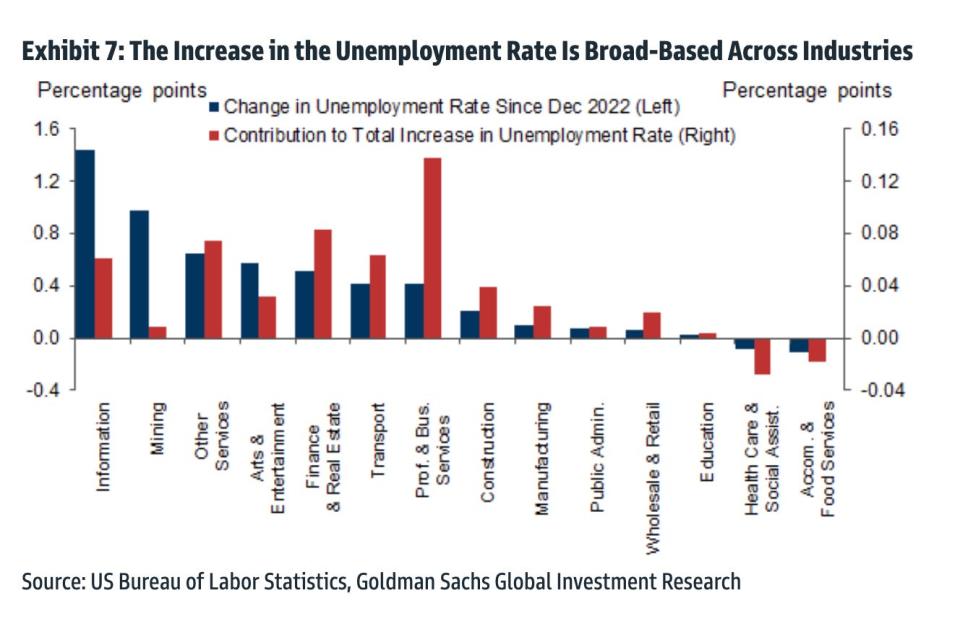Jobs
The job market has 3 weak spots that could bring steeper Fed rate cuts, Goldman Sachs says

-
The job market is flashing mixed signals, according to Goldman Sachs.
-
Weak hiring trends could lead the Fed to cut rates more than expected, strategists said.
-
The bank said hiring conditions are deteriorating faster than in previous years with a rate cut.
The robust US job market has some soft spots, and that could make the case for the Federal Reserve to cut interest rates more than expected, according to Goldman Sachs.
Strategists at the bank pointed to mixed signals in the job market. Job growth remains strong on the surface, but a handful of under-the-radar hiring trends are showing a weaker view of employment, the bank said in a note on Monday.
“While labor market indicators are in an ideal place on average, they send a less consistent signal than before the pandemic,” strategists added.
Comparing today’s job market to previous years when the Fed cut rates also shows some cause for concern. Labor market conditions are stronger overall today, but they’re weakening at a faster clip than in 1995, 1998, and 2019 —years when the Fed cut rates outside a recession, strategists noted.
If the job market continues to weaken, that makes a greater case for the Fed to cut rates, the bank said. Central bankers are projecting just one rate cut by the end of the year.
“We find that the decision to cut has been most sensitive to the unemployment rate and jobless claims historically … Moderate further labor market softening could make downside risks a more central part of the case,” strategists added.
Here are three areas of labor market weakness that could mean more downside for interest rates:
1. Household employment growth has slowed


Household surveys show a weaker picture of unemployment than the official jobs report. When surveying households, the number of new jobs added has fallen behind the official payrolls number by 0.7 million in 2023 and 1.4 million so far 2024, according to Goldman Sachs’ analysis.
Most of that decline is due to the fact that household employment surveys don’t include immigrant workers, the bank said. Employment is also falling among workers aged 16-24, the “most volatile” cohort of the job market, strategists added.
2. The unemployment rate is climbing


Unemployment remains near a historical low, but has ticked steadily higher over the last year. The jobless rate rose to 4% in May. Meanwhile, the three-month average of the employment rate climbed 0.4 percentage points, strategists noted.
“We find that the increase is broad-based across industries. Industries that became somewhat overstaffed such as information and goods transportation have accounted for about one-third of the overall increase, suggesting that some of the increase likely reflects temporary frictional unemployment from relocating workers,” strategists said.
3. The hiring rate has fallen below its pre-pandemic trend
Employers are hiring less than they were before the pandemic. The three-month moving average of the hiring rate has fallen to its lowest level since the pandemic, according to Labor Department data.
Hiring intentions for the third quarter have fallen 8% from levels recorded last year, according to a survey from ManpowerGroup.
That’s largely affected new workers entering the job market. Just 10%-15% of new labor market entrants are finding a job, according to Goldman’s analysis of labor market data.
“The low rate of turnover can be seen as a weak spot, but so far it is not a major problem for most workers,” strategists said.
Other economic forecasters have warned of continued labor market weakness in the coming year, especially as the Fed looks poised to keep rates higher for longer.
The unemployment rate has risen at least 0.5 percentage points in 19 states, according to government data — a sign that a recession could be near, according to one economist.
Read the original article on Business Insider


)






